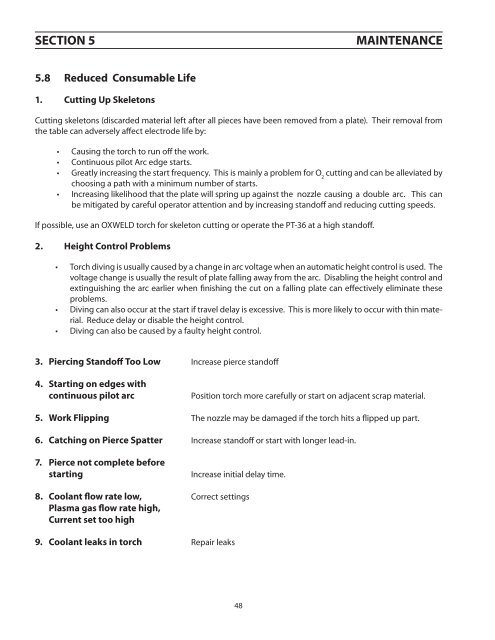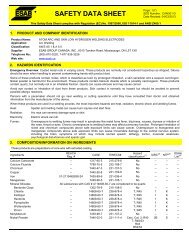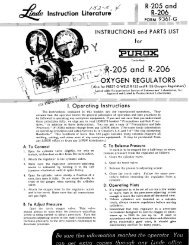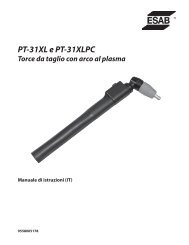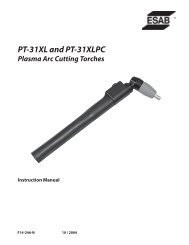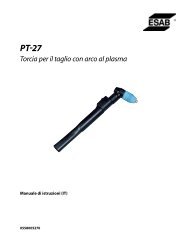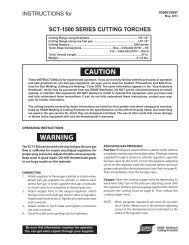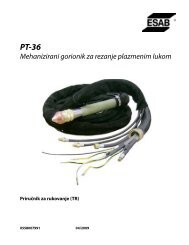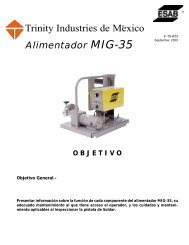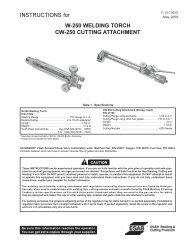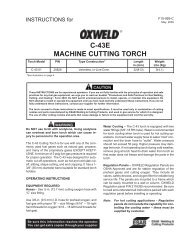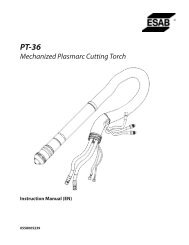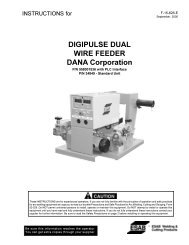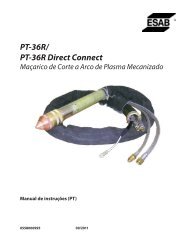Mechanized Plasmarc Cutting Torch - ESAB Welding & Cutting ...
Mechanized Plasmarc Cutting Torch - ESAB Welding & Cutting ...
Mechanized Plasmarc Cutting Torch - ESAB Welding & Cutting ...
You also want an ePaper? Increase the reach of your titles
YUMPU automatically turns print PDFs into web optimized ePapers that Google loves.
section 5<br />
Maintenance<br />
5.8 Reduced Consumable Life<br />
1. <strong>Cutting</strong> Up Skeletons<br />
<strong>Cutting</strong> skeletons (discarded material left after all pieces have been removed from a plate). Their removal from<br />
the table can adversely affect electrode life by:<br />
• Causing the torch to run off the work.<br />
• Continuous pilot Arc edge starts.<br />
• Greatly increasing the start frequency. This is mainly a problem for O cutting and can be alleviated by<br />
2<br />
choosing a path with a minimum number of starts.<br />
• Increasing likelihood that the plate will spring up against the nozzle causing a double arc. This can<br />
be mitigated by careful operator attention and by increasing standoff and reducing cutting speeds.<br />
If possible, use an OXWELD torch for skeleton cutting or operate the PT-36 at a high standoff.<br />
2. Height Control Problems<br />
• <strong>Torch</strong> diving is usually caused by a change in arc voltage when an automatic height control is used. The<br />
voltage change is usually the result of plate falling away from the arc. Disabling the height control and<br />
extinguishing the arc earlier when finishing the cut on a falling plate can effectively eliminate these<br />
problems.<br />
• Diving can also occur at the start if travel delay is excessive. This is more likely to occur with thin material.<br />
Reduce delay or disable the height control.<br />
• Diving can also be caused by a faulty height control.<br />
3. Piercing Standoff Too Low Increase pierce standoff<br />
4. Starting on edges with<br />
continuous pilot arc<br />
Position torch more carefully or start on adjacent scrap material.<br />
5. Work Flipping The nozzle may be damaged if the torch hits a flipped up part.<br />
6. Catching on Pierce Spatter Increase standoff or start with longer lead-in.<br />
7. Pierce not complete before<br />
starting<br />
Increase initial delay time.<br />
8. Coolant flow rate low, Correct settings<br />
Plasma gas flow rate high,<br />
Current set too high<br />
9. Coolant leaks in torch Repair leaks<br />
48


